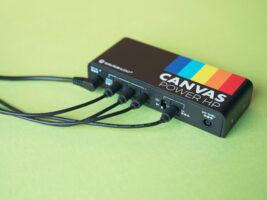
A complete guide to pedal power – how to safely run your stompboxes
It happened to a lot of us when we started messing around with pedals. A battery dies, or you run out of power supply slots – so you find another power supply that looks like it’ll work, pop it in and… boom. A funny smell, some magic smoke and a dead pedal. You check the power supply, and while it fits in the pedal’s power jack, it’s kicking out 18 volts in the wrong polarity – your pedal didn’t stand a chance.
READ MORE: How much headroom do you need? Pedal platform amplifiers explained
It’s easy to look back on those moments and facepalm hard enough to risk firing your skull out of the back of your head. But let’s remember that pedal power is, frankly, weird and stupid, and follows a standard that’s almost the direct opposite to most consumer electronics. In a world where you can power your phone, laptop and beard trimmer all off the same USB-C cable, pedal power is extremely uncooperative in comparison.
And in all of the noise about the effects themselves, important information about how to safely power your effects can get lost in the shuffle. A recipe for potential disaster, obviously, so let’s clear some things up.
You may not be an electrical engineer, and you definitely don’t need to be one to sort out your pedal power. But it is good to have a handle on some of the basic principles. Understanding what’s going on electrically can help you avoid problems and diagnose them when they do occur, plus will help you make more informed decisions when you go to upgrade your power situation.
What is “standard pedal power?”
Some pedals may be described as taking ‘standard’ pedal power. This means 9 volts DC, delivered via a centre-negative 2.1mm barrel jack. If that’s all meaningless to you, don’t worry – we’ll explore those terms in a moment.
Because this is the ‘default,’ so to speak, if a pedal wants something different it will likely be made very obvious in a pedal’s manual or on the case itself. It’s always best to double check, however that’s the basic kind of power most pedals work with.
Standard pedal power is the sort that units like Fender’s Engine Room specialise in – these supplies offer fully-isolated, clean DC power that works with the vast majority of stompboxes.
[deals ids=”4USkAq60Oq3teKITuvtl4T”]
Voltage and polarity
Voltage and polarity are the two things you need to be extra careful about. Getting either of these things wrong can fry a pedal, sometimes beyond the point of reasonable repair. For a single power supply – the kind that plugs straight into the wall – both voltage and polarity will normally be marked on the plug itself.
Polarity is indicated by a small symbol – for centre-negative, there’ll be a plus sign shown on an outer ring and the minus on an inner dot. If it’s the other way around, with the plus on the inner dot, it’s centre-positive. Very few pedals take centre-positive supplies – however, centre-positive is the standard for basically all other consumer electronics that use this kind of barrel jack. So while other plugs may fit, you want to make sure that you’re using a pedal-specific, centre-negative DC power supply unless otherwise specified.
And as long as it’s a pedal-specific supply, it’ll be DC. There are some rare pedals that need AC supplies – some tube pedals need AC to power their heaters, etc – but these are very much the exception, and it’ll be made clear on the pedal or the manual what kind of power they need, and they’ll either take a full-sized IEC cable or come with their own bespoke supply. AC – alternating current – can be just as damaging to a pedal as reverse polarity. Be careful, and don’t just use any old adaptor that you find lying about!
For a dedicated multi-output supply, each output should be labelled with its voltage and maximum current output.
What about higher-voltage pedals?
Some pedals – emphasis on some – are able to be run at higher voltages, most often 12 or 18 volts. There are two ways to achieve this – either they are built to accept higher voltages that you provide, or they utilise their own internal charge-pumps – small circuits capable of converting lower voltages to higher voltages. They do this to provide more headroom, as it means certain amplifying circuits can handle louder signals before they start to distort.
Some power supplies will have dedicated 12 or 18 volt outputs, which are great for these kinds of pedals. They may also have some outputs that have selectable voltages. Be extremely careful when setting up pedals like this – double- and then triple-check a pedal can actually accept the higher voltage – you definitely don’t want to feed 18 volts into a pedal that has its own voltage doubler, or one just not built for that kind of power. And if you’re changing things up – remember which outputs you’ve set to higher voltages!
What about “voltage starving”?
Alternatively, some pedals – mostly fuzzes – can sound great when provided with less voltage, also known as “voltage starving”, “voltage sag” or the “dying battery” sound. When you decrease the voltage, you can get a gated, blown-out sound as the transistors are far more easily overloaded.
Some power supplies feature fully variable outputs to achieve this, or there are bespoke units like the JHS Volture which you can put between your supply and your pedal.
Keep in mind that this really only applies to analogue fuzz pedals, and you’ll either get no sound or risk damaging something if you under-volt a digital pedal.
How much current do you need?
Mono Power Supply Large, powered. Image: Mono
Current is a bit of a different consideration to voltage. It is a measurement of the rate of flow of electrons, whereas voltage is the electrical potential that’s driving those electrons through the circuit. Unlike voltage, your power supply cannot have too much current, only too little.
Why? Well, how much current a circuit uses at a given voltage is a property of the circuit itself. If the supply is capable of delivering enough current, the circuit will take as much as it needs, and no more.
As with all things that describe the workings of electricity, let’s use a very simplistic analogy that only slightly risks confusing you more. Imagine a load of electrons all waiting patiently in a queue. When they get to the front of the queue, they’re fired at your pedal by a big cannon. The cannon is voltage. The size of the queue is the maximum current output. If the cannon is too powerful, things could break. But if the queue is too big, it doesn’t really matter..
If the supply doesn’t provide enough current, the results aren’t usually that disastrous – digital chips can fail to boot, and you might get some weird noises, intermittent signal or none at all, but you’re unlikely to blow the pedal up by underpowering it.
However, you may be putting undue strain on your power supply if you’re running a very thirsty pedal off an output that can’t quite keep up. Don’t take risks – check the manual of both the pedal and the supply if you’re unsure.
Most analogue pedals don’t draw a lot of current. Things like fuzzes and overdrives can need as low as 3mA. However, just because something’s analogue, it doesn’t mean it’s got low current requirements – some more complex drive units need a lot more juice. This is a consideration when daisy-chaining, which we’ll
Digital pedals, on the other hand, may need a lot more current. Most Strymon pedals need 300mA – UAFX pedals need a whopping 400mA! While they still require standard 9V centre-negative DC supplies like you would use with most other pedals, you’ll want to ensure that you’re using outlets with enough current for involved digital effects. Similarly, if you’ve got an analogue pedal with a real tube in it, that will likely need a good deal more current than other drive pedals.
Isolated supplies, daisy-chaining and noise
Input and standard 9V input jacks for power on the Donner Triple Threat. Image: Adam Gasson
If you’ve ever looked into upgrading from batteries to a power supply, you’ll often see people extolling the benefits of isolated power supplies. But what does this mean, and why is it important?
A non-isolated supply means that you’re converting from wall voltage down to what a pedal needs once, and then running different pedals in parallel off this – the ground and the positive of the different outputs are directly electrically connected, with current flowing between them. This is the same as daisy-chaining with a splitter cable – hence you might see some non-isolated supplies referred to as simply daisy chains in enclosures.
Isolated means that power is being converted from wall voltage to what a pedal needs per pedal. The ground connections are isolated from each other by a transformer – no physical current is able to flow between the different supplies’ connections.
Why is this distinction important? Say you have a powerful digital reverb and an overdrive daisy-chained off the same power connection. The digital reverb is effectively a small computer, and so has a clock circuit that steps the CPU through its processes. Each time the CPU takes a step, it needs a little momentary pulse of extra current – and it’s taking a step thousands of times a second.
If the overdrive isn’t on an isolated supply from the reverb pedal, it will also experience this current fluctuation. This will often result in an unpleasant, high-pitched sound, known as clock whine. But if the digital reverb is using its own isolated supply, there’s no way for that current fluctuation to affect the power the overdrive is getting – so things will stay nice and clean!
This is often the main benefit of upgrading to a fully isolated power supply. It’s totally possible to daisy-chain together low-current analogue drive pedals without any problems.
But if you are daisy-chaining digital pedals, or mixing digital and analogue stuff on the same outlet, you may be getting extra noise. Additionally, digital pedals aren’t the only things with clocks – LFO-based modulation effects, even if they’re analogue, can introduce their own clock noise thanks to their fluctuating current requirements.
The other benefit is that, generally, you’re less constrained by current draw. When you daisy chain pedals together, the amount of current the supply needs to provide is the total current draw of all of the pedals that are on the same outlet. For low-current analogue pedals this is normally fine. However, if you’re daisy-chaining together anything that requires some serious amount of juice, you may be straining your power supply.
So how do I power my effects pedals?
There are plenty of power supply solutions out there depending on what you need. Obviously, if you’re only using a few low-current analogue pedals at once, you can get away with daisy-chaining off a single power-plug – if you’ve ever bought an EHX pedal, you’ll likely have one lying about.
However, if you’re building a dedicated pedalboard, you’ll likely want a bespoke isolated supply. My personal power supply of choice is Harley Benton’s PowerPlant ISO range – they strike a great balance between sturdiness, affordability and a great range of output options. The AC variants are particularly practical – they can be chained together for larger boards, and the fact they accept sturdy IEC cables is reassuring. Not only are IEC cables easy to replace, they’re much more resistant to knocks – reassuring when using my board on a stage!
[products ids=”45espBmfWbcStk2GCMQmdD”]
[products ids=”2kHe1vEtWHJLs5q6eIlfGw”]
[products ids=”1lD2lM9TosGQ9MyQT7xg0z”]
The post A complete guide to pedal power – how to safely run your stompboxes appeared first on Guitar.com | All Things Guitar.
Source: www.guitar-bass.net











